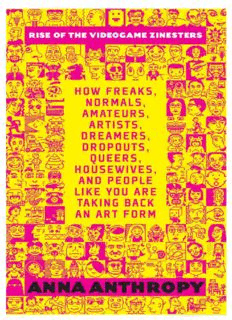
Rise of the Videogame Zinesters: How Freaks, Normals, Amateurs, Artists, Dreamers, Drop-outs, Queers, Housewives, and People Like You Are Taking Back an Art Form PDF
Preview Rise of the Videogame Zinesters: How Freaks, Normals, Amateurs, Artists, Dreamers, Drop-outs, Queers, Housewives, and People Like You Are Taking Back an Art Form
Copyright © 2012 by Anna Anthropy A Seven Stories Press First Edition All rights reserved. No part of this book may be reproduced, stored in a retrieval system, or transmitted in any form or by any means, including mechanical, electronic, photocopying, recording, or otherwise, without the prior written permission of the publisher. Seven Stories Press 140 Watts Street New York, NY 10013 www.sevenstories.com College professors may order examination copies of Seven Stories Press titles for a free six-month trial period. To order, visit http://www.sevenstories.com/textbook or send a fax on school letterhead to (212) 226-1411. Book design by Elizabeth DeLong Library of Congress Cataloging-in-Publication Data Anthropy, Anna. Rise of the videogame zinesters : how freaks, normals, amateurs, artists, dreamers, drop-outs, queers, housewives, and people like you are taking back an art form / Anna Anthropy. p. cm. Includes bibliographical references and index. ISBN 978-1-60980372-8 (pbk.) Ebook ISBN: 978-1-60980-373-5 1. Video games. 2. Video games--Social aspects. I. Title. GV1469.3.A53 2012 794.8--dc23 2011045409 Printed in the United States 9 8 7 6 5 4 3 2 1 For the child I was, the book no one could write for me. Contents Chapter One: The Problem with Videogames Chapter Two: The History of Magic Chapter Three: What Is It Good For? Chapter Four: Changing the Game Chapter Five: The New Videogame Chapter Six: Making the Games Chapter Seven: By Your Bootstraps Chapter Eight: Growing Up Appendix A: What to Use Appendix B: Zinester Games About the Author Chapter One The Problem with Videogames I have a problem with videogames.1 Plenty of people seem to have problems with videogames these days. Newscasters are fond of reporting that videogames are dangerous to children, either because they teach children how to steal cars and kill cops or because they actually connect children electronically to the gameplaying predators who are waiting to snatch them away. Religious leaders have wasted no time condemning videogames as a trap for children’s souls, and armchair psychologists accuse them of turning kids into antisocial hermits. People condemn videogames because videogames are pervasive in popular culture. They’re on our computers and our cell phones, in our homes and purses and pockets. Even if you yourself don’t play games, you have a hard time escaping their marketing. When the television isn’t telling you to be afraid of videogames, it’s telling you to buy them, and to drink World of Warcraft– flavored Mountain Dew while you play. These are some problems people have with videogames. What’s my problem with videogames? As a queer transgendered woman in 2012, in a culture pervaded by videogames —a culture in which, typing on my computer, I am seconds away from a digital game, even if I have not taken the time to buy or install a single game on my computer—I have to strain to find any game that’s about a queer woman, to find any game that resembles my own experience. This is in spite of the fact that videogames in America and elsewhere are an industry and an institution. I’ve already brought up World of Warcraft, a game about performing repetitive tasks until numbers increase. So, now that we’re in the land of numbers, here are some numbers. The ESA—that’s the Entertainment Software Association, who spend half their time assuring the population that videogames aren’t worth being mad at, and the other half pursuing litigation against anyone who distributes games that their shareholders have long since stopped distributing or profiting from—claims that, as of 2009, 68 percent of American households play digital games.2 In 2008 alone, people bought 269,100,000 games (the ESA word is units.)3 So digital games, by the numbers, are here, and they take up a lot of space. And almost none of these games are about me, or anyone like me. What are videogames about? Mostly, videogames are about men shooting men in the face. Sometimes they are about women shooting men in the face. Sometimes the men who are shot in the face are orcs, zombies, or monsters. Most of the other games the ESA is talking about when it mentions “units” are abstract games: the story of a blue square who waits for a player to place him in a line with two other blue squares, so he can disappear forever. The few commercial games that involve a woman protagonist in a role other than slaughterer put her in a role of servitude: waiting tables at a diner (or a dress shop, a pet shop, a wedding party). This is not to say that games about head shots are without value, but if one looked solely at videogames, one would think the whole of human experience is shooting men and taking their dinner orders. Surely an artistic form that has as much weight in popular culture as the videogame does now has more to offer than such a narrow view of what it is to be human. And yes, from here on out I’ll be talking about videogames as an art form. What I mean by this is that games, digital and otherwise, transmit ideas and culture. This is something they share with poems, novels, music albums, films, sculptures, and paintings. A painting conveys what it’s like to experience the subject as an image; a game conveys what it’s like to experience the subject as a system of rules. If videogames are compared unfavorably to other art forms such
Description: